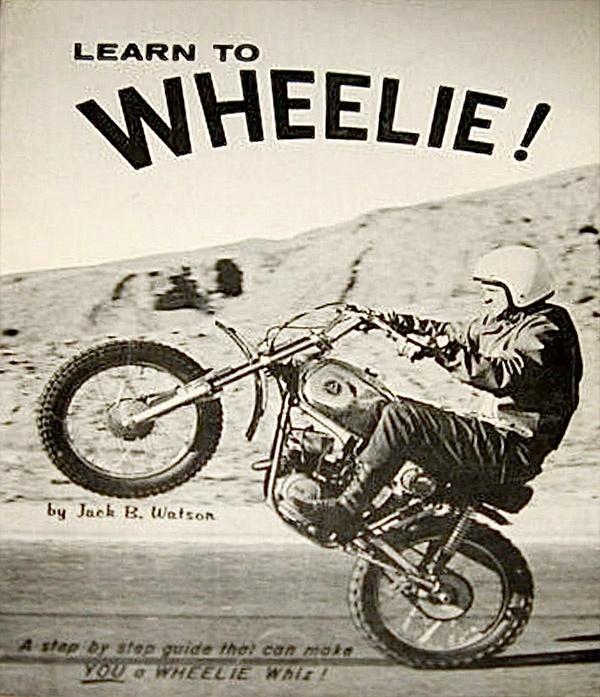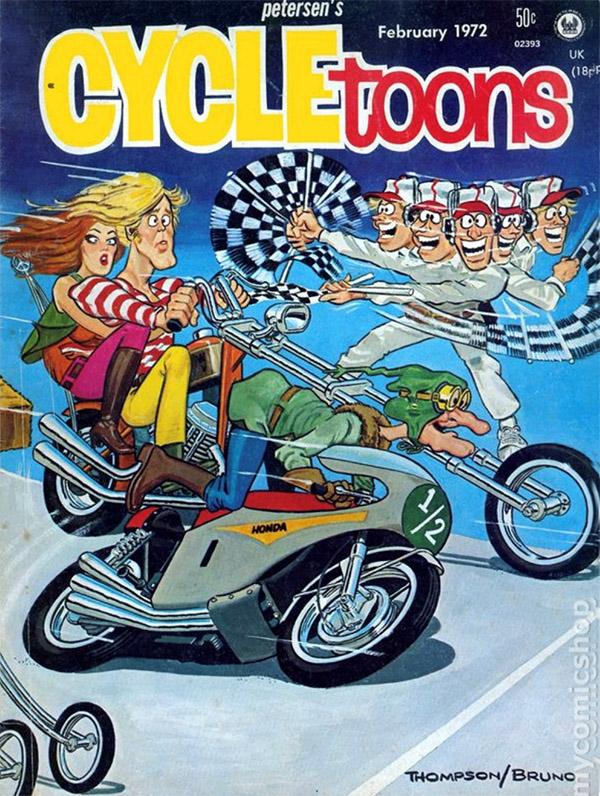Recently Berk wrote a story on his five best motorcycle books. I figure I’ll copy him since nothing else moto-related is going on. Berk’s choices were all good choices but naturally not the ones I would have picked. Berk and I differ on a lot of topics (ok, most) but we don’t let that stop us from getting along well. Maybe it’s my deep-seated conviction that I am always right or maybe it’s because I actually am always right that smooths troubled waters. It’s hard to tell, really. Whatever it is it works so I’m not going to over-analyze the thing.
The thing is, I don’t read many motorcycle books, and five will be a stretch. Sure, I’ve read Berk’s travel books but only the ones with me in them. I have nothing against travel/adventure books but as a rule, it’s a topic that I would rather do than read about. I’m going to take a stab at the five-list anyway.

My top pick for all-time best motorcycle book is Floyd Clymer’s A Treasury of Motorcycles of the World. This huge hardcover was my bible growing up. I read and re-read the thing so many times I knew it by heart. The Treasury
came out just slightly before the age of Japanese superbikes and reading it you get no sense of the dramatic changes that were about to sweep over motorcycling. The Treasury
covered practically every brand that you could find in the USA: Harleys, Triumphs, Hondas and the rest. The more obscure brands were covered also. What seems obvious to us now was at that time still up in the air. The Japanese were making inroads but one look at the outsized 4-cylinder Munch and you suspected car-engined motorcycles were the future. In such a fast moving business, who knew which marques would be successful?
The Treasury covered more than just motorcycles. Included were descriptions of motorcycle culture and motorcycle events. A debate between Triumph and Suzuki on the merits of two-stroke vs. four-stroke stands out in my mind. I sided with Suzuki. If you were completely new to motorcycling this one book would bring you up to speed on the whole shebang.
Maybe I’m remembering the Treasury with rose-tinted neurons. I lost the book somewhere over the 53 years since I read it last and I can’t be bothered to buy another copy of The Best Motorcycle Book Ever. I’d rather keep the knowledge I gained from the book: the excitement and wonder from its pages and a life long infatuation with two-wheeled travel. I’ll not risk my entire life history to a few mis-firing neurons.

Next on my list of all-time greats is a book I’ve never read. Learn To Wheelie by Jack B. Watson was advertised in the back ads of the many, many motorcycle magazines I devoured as a youth. The book must have sold by the thousands because the ads ran at least 20 years. That alone should tell you how good Learn To Wheelie is. I wanted to buy a copy for all those 20 years but money was scarce and I ended up learning to wheelie by trial and error.
Trial and error was how most of us learned to wheelie and it was a hard won skill. One time I flipped over backwards on my Honda SL70 doing around 45 miles per hour. I landed on my back and the asphalt wore through at each of my vertebra leaving little, quarter-sized cherries to mark out each one in a zipper-like fashion.
The SL70 continued on for few yards longer and when the front wheel came down the bike started cartwheeling in the middle of the road. It bent the swing arm, the frame, the handlebars and broke any sticky-outtie parts clean off. It was like the SL70 had spent a few hours in a cement mixer. Things would have gone a whole lot different had I read Learn To Wheelie. A whole lot different.

If you asked me, and you didn’t, I’d say the book that had the most influence on my feverish teenaged brain was Cycletoons. Not that Cycletoons
is exactly a book. It’s a comic book and that has the word “book” in it so in my book it qualifies. Cycletoons
came out once a month for a few years and in that short time did permanent damage to my personality. The artwork and stories were fantastic, running from hardcore nuts and bolts stuff to fantasy pieces that mimicked drug induced psychosis.
Unlike Clymer’s Treasury, Cycletoons came out in the early 1970s right when motorcycling in the USA was coming on the pipe. Up to date in every way with cultural references ripped from the headlines, Cycletoons
put all the traditional, stodgy motorcycle magazines on the trailer. Some of the humor (and it was all humor) was pretty lame but when it was good it was the best. The artists and writers of Cycletoons
were mostly young guys that knew what was happening and they used the language of the day to tell their stories. Something you rarely saw back then.
Webley-Vickers, The Ol’ Poop, Cycle Chicks, the lonely hearts mail page, Pillow Trot and Elbow Juice, I loved all of it and haunted the local 7-11 store eating Lemon Heads and waiting for the next issue to come out. Cycletoons magazines are fairly expensive now. They go for 30 to 50 bucks a copy on Amazon so I won’t be buying them. I think I still have one issue saved. It’s the one with the cover art of all the Cycletoons
characters along with Skip Van Leeuwen, Nixon, Romero and a few other famous racers powering into turn one on everything from a broken down chopper to a Vespa scooter. If you find a stack of Cycletoons
at a garage sale snap them up. I guarantee you’ll love them.

If you are into old clunkers like I am Chilton’s Motorcycle Repair Manual is the one book you’ll need for whatever crappy old motorcycle lands in your garage. The thing is massive, weighing over 6 pounds, and covers in detail most 1950-ish to pre-1973 motorcycles. This book has saved me so many times I refuse to count that high. While not the same as a one-make-and-model shop manual Chilton’s Motorcycle Repair Manual
gives you enough information to fix most any old bike out there.
Beyond it’s practical applications, Chilton’s Motorcycle Repair Manual is enjoyable as pure entertainment. Looking over the repair procedures for a bike I will never own is a guilty pleasure. The book covers Z1s and H2s and has helped me make decisions about bikes on my wish list.
Structurally, Chilton’s Motorcycle Repair Manual is pretty flimsy. The hard covers are there to protect the super thin, magazine quality paper inside. I guess that was the only way fit in all the information and keep the beast to 6 pounds. Turn the pages carefully, my brothers. Oddly a used Chilton’s Motorcycle Repair Manual
is not that expensive to buy. $35 is a cheap price to pay for the joyful information contained within.

Last but not least is another book I haven’t read but I do have it on order from Amazon. One Man Caravan by Robert Edison Fulton, Jr. One Man Caravan
deserves it’s lofty spot simply because it’s The Mother of All Adventure Books. Nowadays everyone and their mother are riding motorcycles around the world and publishing a book about it. We’ve become complacent. Bored with the same old stories. Fulton did it way back, between the first horror of WW1 that was supposed to end all wars and the second, more complete horror of WW2. Fulton did it before it was a thing and he rode a (Douglas?) which makes him much, much cooler than anyone else. All the reviews I’ve read about the book are rave so I look forward to reading the thing when it shows up.
It’s a sad thing when your list of five best motorcycle books has two books you haven’t read but there is nothing I can do about it now. Let me know if I’ve missed any!
Never miss an ExNotes blog. Sign up here:
Here’s that link again, just in case you missed Berk’s five best motorcycle books.
Do us a solid: Please click on the popup ads!
Here’s why you should click on those popup ads!
If you’re heading into Mexico, be sure to insure with BajaBound Insurance!




I looked into a couple of these. People who still have them for sale are very proud of them. That’s what I get for being 50 years behind the curve.